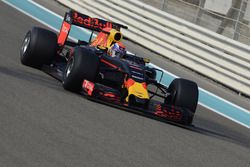Pirelli fears new F1 rules could lead to processional races
Pirelli fears that Formula 1's 2017 rules revamp could result in processional races if the performance gaps between teams ends up being too big.

Photo by: Mercedes AMG












Despite F1's tyre supplier having overhauled its tyre concept to deliver low degradation tyres that have different thermal characteristics to help drivers push harder, there are widespread concerns that the aero changes coming to the cars will hurt overtaking chances.
Pirelli motorsport director Paul Hembery concurs that the spectacle may suffer in 2017, and that efforts his company has made to help improve the racing may not be able to help the situation.
When asked if he was predicting the new aero rules to help deliver a great season for F1, Hembery told Motorsport.com: "I think the drivers will enjoy it – because with that level of performance, you are going to feel it aren't you? That will give them a physical challenge they haven't had for a while.
"But the true impact of overtaking will be down to the [relative] performance of the cars. If the performance of the cars is close together, then there might be chances – if they aren't then it will be a procession."
Low degradation
Pirelli has been asked by drivers and the FIA to deliver tyres that have very low degradation, which moves away from the philosophy it has followed in recent years.
Hembery is sceptical about the benefits of the change of emphasis, as there will be less variation in performance between cars and a likely move away from two-stop races.
Asked how the new era would compare to the start of Pirelli's era, and especially its second season in 2012 when there were seven different winners in the first seven races, Hembery said: "It is going to be quite the opposite to that – but that is what the sport has asked us to do.
"It asked us to do that [high degradation tyres] back in 2011, and now we are being asked to do something else. We will ask it to the people to ask what is the best approach. We are just trying to deliver what we have been asked to deliver.
"On any of these subjects, there are always some pros and some against. I think we will know after five or six races what we have done and if it is right or wrong."
Driver benefits
Although sceptical about the 2017 racing, Hembery has faith that the move away from tyres that have thermal degradation will allow drivers to push harder if they can get close to their rivals.
"We have six years where the input was to create a challenge for the teams and drivers – a thermal challenge where you had to manage overheating and degradation," he said.
"Now we are going to a situation where we are asked to reduce that, so the thermal overheating is significantly reduced and wear levels are reduced, so the drivers in overtaking situations can push harder and not go into an overheating scenario.
"That needs to be combined, of course, with the aero changes that reduce the level of disturbance of the air that arrives to the front of the following car. That, combined with the tyres, should enable people to make more aggressive overtaking manoeuvres.
"But on the other side there are going to be more corners flat out, and that is not going to help overtaking because people won't be backing off as there is no braking."
New characteristics
Hembery was sure that Pirelli's 2017 rubber would allow drivers to get tyres back into their operating window if they do get too hot – something that was not possible with the previous generations of tyres.
"You can bring it [the temperature] back now – but we still have to see it on the correct car," he said. "The philosophy is there and that is what we have seen in testing up until now, so we are confident we are in the right direction.
"Have we been too conservative and not aggressive enough? That is something that we will only understand when we see the actual cars. But certainly from a philosophical change in the way we approach it, there is a notable change."
Be part of Motorsport community
Join the conversationShare Or Save This Story
Subscribe and access Motorsport.com with your ad-blocker.
From Formula 1 to MotoGP we report straight from the paddock because we love our sport, just like you. In order to keep delivering our expert journalism, our website uses advertising. Still, we want to give you the opportunity to enjoy an ad-free and tracker-free website and to continue using your adblocker.














Top Comments